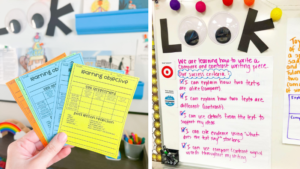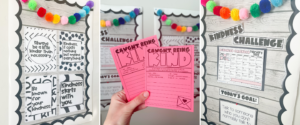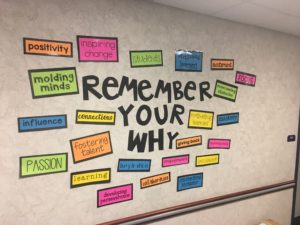
Empowering students with the ability to track their own progress and monitor their own goals can increase their academic achievement, as well as promote a positive social-emotional well-being.
One way to support students in this process is by having them create SMART goals.
SMART goals are specific goals that helps students (and teachers) understand how a goal will be met, measured, and reached in a timely way.
It is an acronym that stands for
S-Specific
M-Measurable
A-Attainable
R-Relevant
T-Timely
When supporting your students in developing SMART goals, it is imperative that students understand what each aspect of the SMART goal means, how it can be applicable to real life, and how they’ll be taking responsibility for it.
To do this, start the school year off implementing SMART goals about activities or hobbies students have outside of the classroom or attributes that will help them be a successful student for the new school year. You can even use those same guidelines for your introduction of SMART goals if you’re starting to implement in the middle of the school year.
If you want this to be effective and if you’d like for your students to get the most out of this activity, be intentional about how you’ll deliver the information. Walk students through examples. Create and share your own SMART goals while tracking your progress with the class. Have them share their goals with each other. Be explicit in your teaching and guidance as you’re first setting this system up for your class.
Here’s a sample lesson I’ve done with my students to help them set up their SMART goals:
Learning Intention:
We are learning how to create SMART goals using specific, measurable, attainable, relevant, and timely descriptions.
Success Criteria:
- I can identify things I want to improve upon in and outside of school.
- I can explain why making goals is important.
- I can monitor/track my own progress towards meeting a goal.
Hook:
Start the lesson with a question like “What is something that you’ve had to work really hard at in order to be better or change?”
Engage students in a quick (2-3 minutes) conversation about this topic. Students can first think, pair up, and then share their ideas using the following sentence frames:
- I wanted to improve in ____ because ___.
- Something I’ve had to work really hard at is ___ because ___.
- In order to change or be better at __ I had to work hard ___.
Encourage students to think about what they’ll say so they’re prepared to share with their partner.
Learning Intention:
Let students know the learning intention for the lesson by connecting the hook and what was discussed. You can say something like, “When you want or need to work really hard at something in order to be better, you can make a goal. Today we’re going to think about some of the things we want to work on and we’re going to make a specific goal called a SMART goal.
During this, let students know the success criteria for the lesson as well, by explaining that these are things they have already done and can continue to do as they try to meet their goal.
Success Criteria:
- I can identify things I want to improve upon in and outside of school.
- I can explain why making goals is important.
- I can monitor/track my own progress towards meeting a goal.
Big Idea:
Take a few minutes to explain the importance of establishing SMART goals, and not just a goal like “I will be better at playing basketball” or “I will be better at math.” The reason for using SMART goals is to be specific so we can help ourselves meet the goal, track our progress, and make changes along the way if we need to.
Model/Guided Practice:
Start modeling how you would make your own SMART goal. It’s up to you if you want the whole class to choose something that is not academic-related, academic-related, or let them have the choice of which they want.
Go through each section of the SMART goal template and fill it out, modeling by using metacognition and thinking out loud to express how you’re coming up with your goal. Save the “My Goal” line for the end, after you’ve finished filling out the template. This will help you identify your goal more easily. Tell your students the same thing.
Use the provided sentence frames while you’re creating your goal so students know that they can also use them to create their own goals.
Stop after each section of the SMART goal and have students come up with their own goal. This is where there’s modeling and guided practice mixed together. For example, after you’ve modeled the “S” portion of the SMART goal template, ask students to first think about what they want to work on for their SMART goal. Remember to help them narrow down choices (academic/non-academic, sports, etc.). They can use one of the sentence frames to help them shape their thinking. Once they’ve thought about it, they can write it down on their template. After they write it down, have them share their ideas with a partner. While they’re sharing with partners, walk around and listen to students’ ideas. As you’re listening, ask a couple students if they’d be willing to share their goals with the class. After you’ve chosen those students, have them share their goals. You can even write them on the board or an anchor chart to collect students’ ideas.
Do the same steps for each letter of the template.
Once you’ve completed the template, go back and fill in the goal on the line where it says “My Goal.”
You can use the square template of the SMART goals sheet, too. Students can write their goal on the square paper and tape it to their desk.
You can also use the adhesive pocket squares and adhere it to students’ desks.
Closure:
Take time to have students share their SMART goals with one another. You can close the lesson by asking some simple closure questions:
- What did we learn today?
- How can we be successful and meet or come close to meeting our SMART goals?
- Why are SMART goals important?
Have students create new SMART goals every quarter or after each unit of study. It’s up to you how you want to structure the relevance of SMART goals in your classroom. You can also use it as an opportunity for students to track their own assessment data that’s related to their SMART goals.
Click here to grab my SMART Goals template in my shop.




